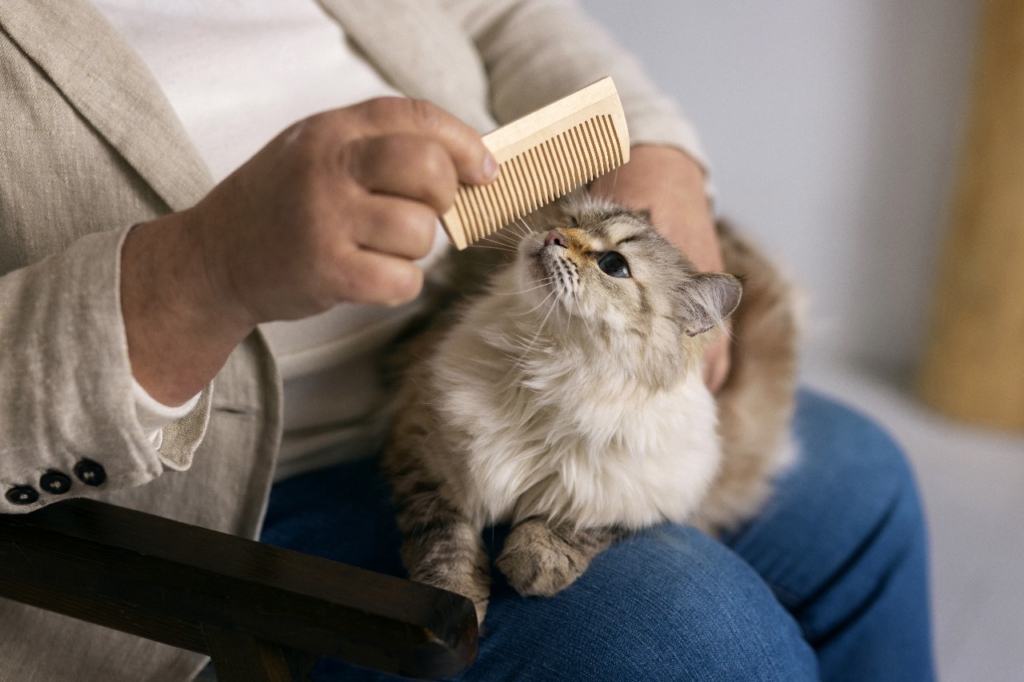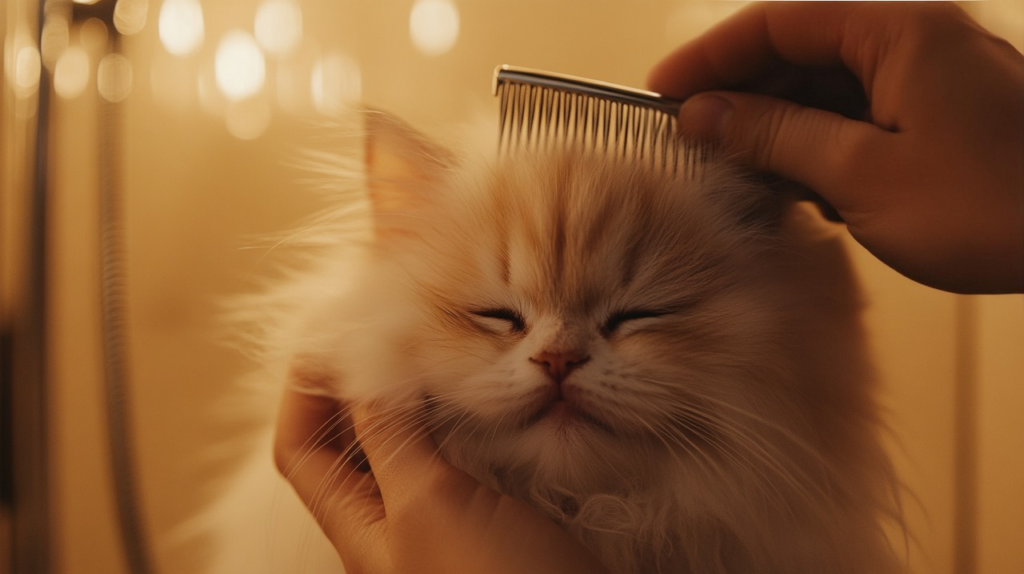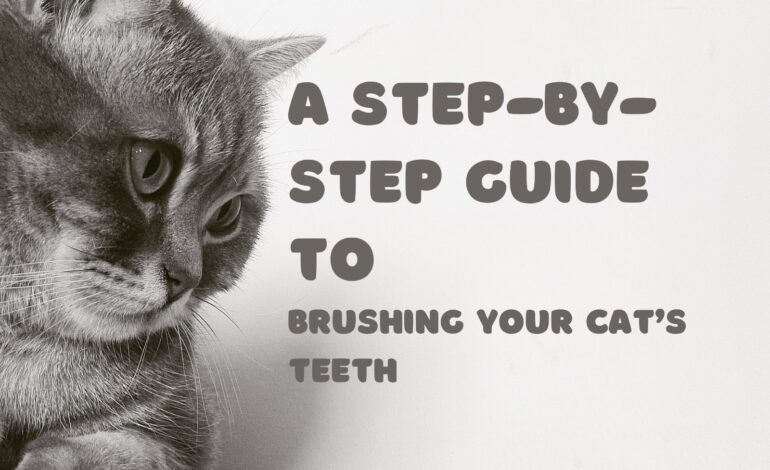Brushing Your Cat for the First Time: Essential Tips for Owners in Montreal

Hey, Montréal cat parents! Regular brushing isn’t just about a glossy coat—it helps remove loose hair to curb hairballs, keeps the skin comfortable, and supports seasonal shedding (handy in a city that still sees multiple 30 °C+ days most summers (1)). It also doubles as a mini health check: while you brush, you can spot lumps, skin issues, or parasites early, and the routine itself can strengthen your bond through gentle, positive handling. If you’re a first-time owner, take a breath—start with short, calm sessions and treats, and most cats learn to enjoy it.
Why Brushing Your Cat Matters

- Removes dead fur & reduces shedding. Cats spend 30–50% of their day grooming; brushing lifts loose undercoats so less hair is swallowed (fewer hairballs) and shed around the home. Studies show that adding a bit more fiber (like psyllium) to a long-haired cat’s diet can actually help them pass more hair naturally within just two weeks making brushing even more effective for hairball control.(2)
- Prevents matting & hairballs. Brushing regularly keeps tangles from turning into painful mats, which can hide skin problems or even fleas.Cornell vets suggest daily combing during shedding season, since it’s the best way to keep hairballs under control.(3)
- Stimulates skin & supports circulation. A gentle brush doesn’t just remove loose fur—it also boosts circulation and helps spread your cat’s natural oils, keeping their coat soft and shiny.
- Builds trust & strengthens your bond. Many cats enjoy brushing, and vets note grooming time can be used as a reward and bonding session when done calmly and positively.
- Early detection of fleas, ticks, or skin issues. Brushing doubles as a mini-exam: you can spot parasites and skin changes early; check pets for ticks daily if they go outdoors, and remember mats can hide pests or scabs.
Preparing for the First Brushing Session
- Right time & place: Choose a calm environment after a meal or playful activity. Calm behaviors can be encouraged with Feliway diffusers or cat-specific music.
- Trim nails (optional): May be optional, but the ASPCA recommends trimming them every 10 days to 2 weeks to avoid scratches. If the cat resists, it’s best to ask a vet for a demonstration. (4)
- Introduce the brush: Use your cat-specific brush to let your cat sniff the brush first, and then allow it to rub against the brush. Help your cat focus by giving treats during the strokes to build an association to the brush.
- Use rewards: Completing every session with a positive attitude, and giving calm praise followed by a small treat, is a great way to build up positivity.
Choosing the Right Brush for Your Cat

Picking the right grooming tool can make all the difference—especially for sensitive kitties or those with long, tangle-prone coats. Here’s a breakdown of the best brush types with insights from testing and owner feedback:
- Short-Haired Cats
A gentle rubber brush or fine-toothed silicone brush is ideal. These brushes have a soft touch and effectively gather loose fur without causing irritation. - Long-Haired Cats
Use a combination of a wide-toothed comb and a slicker brush. The slicker works through the undercoat to remove tangles, while the comb helps prevent matting. - Self-Cleaning Slicker Brushes
These brushes are highly convenient—they allow you to retract collected fur at the push of a button and work well across different coat types. - Grooming Gloves
Perfect for cats who dislike traditional brushing. These gloves mimic petting and gently pick up loose hair. Many cat owners find them especially effective for heavy shedders and calming for sensitive pets. - Sensitive Cats
For delicate felines, combs with very soft rubber or silicone tips are usually the most comfortable and well-tolerated.
How to Brush a Cat for the First Time
| Step | What to Do | Why It Matters |
| 1. Start with Comfort Zones | Brush the back or sides first, avoiding belly and tail initially. | Builds trust and prevents stress. |
| 2. Brush with the Fur | Always follow the natural direction of hair growth. | Reduces pulling and discomfort. |
| 3. Keep It Short | Begin with 3–5 minute sessions. | Helps your cat adjust gradually. |
| 4. Extend Over Time | Slowly increase session length as your cat gets used to it. | Makes brushing part of their routine. |
| 5. Reward & Praise | Offer treats, pets, or play after each session. | Creates positive reinforcement. |
Tip: Watch for Stress
Stop if your cat swishes its tail, flattens ears, or tries to escape. This prevents negative associations with brushing.
Dealing with Mats and Tangles
Cornell researchers found that long-haired cats are five times more likely to get tangled than short-haired cats if neither is brushed daily. Brushes should ideally be used once a day. The daily brushing routine is vital to avoid incredibly uncomfortable knots.
Small tangles can be resolved with cat-safe detangle spray to ease the brushing process. Do not use scissors! The skin of cats is very thin and the number of cats that get injured and neutered after unintentional cuts during mat removal is very high.
The best way to resolve severe and tightly bound mats is to visit a professional groomer in Montreal. Locally, a number of groomers focus on cats which means that they can relieve stress during the process to avoid infections and skin irritation.
Beyond Fur: The Best Way to Brush a Cat’s Teeth

- Dental health is essential: Believe it or not, around 7 in 10 cats show signs of dental disease by the time they’re just three years old.
- Use the right tools: Always choose a cat-specific toothbrush and toothpaste. (⚠ Never use human toothpaste—fluoride and xylitol are toxic to cats).
- Start gradually: Let your cat lick or taste the toothpaste before brushing.
- Keep sessions short: Begin with gentle strokes on the outer surfaces of the teeth; aim for a few seconds at first.
- Build consistency: Brush a few times per week and extend the duration as your cat adapts.
- Health benefits: Prevents plaque buildup, gum disease, bad breath, and lowers the risk of systemic health issues.
Where to Find Professional Groomers in Montreal
If brushing your cat at home feels overwhelming, these Montreal-based cat groomers can help:
- Urban Loulou Wellness Center Inc. – Offers a holistic grooming approach with wellness-focused care.
- Toilettage Felinus Inc. – Specialists in cat grooming services including shaving, brushing, and nail care.
- Lave TouTou – Provides a stress-free grooming environment to keep your cat calm.
- Toutou Village – Affordable grooming with pet pick-up and drop-off services for added convenience.
Final Tips for First-Time Cat Owners
- Be patient – Cats need time to adjust to grooming.
- Don’t force it – Let your cat set the pace and stop if they seem stressed.
- Make it positive – Pair brushing with cuddle time, treats, or gentle praise.
- Stay consistent – Regular grooming keeps your cat’s coat healthy, reduces shedding, and strengthens your bond.
Conclusion
The first time you try to brush your cat it might seem a little difficult at first, but it might just turn into an enjoyable experience. In addition to keeping the cat smoother and brush-free, proper care decreases the amount of shedding and improves the skin, and one’s relationship with the cat as well.
For new cat owners, pay attention to this advice: go at the cat’s pace. Keep brushing sessions fun, and try to do them regularly.
Cat owners, do not worry, at Meow Care Hub, we will help you through all your challenges. This is especially true when the care involves more than just brushing.
For more tips, you can go on the Meow Care Hub and they will help you make it an enjoyable experience for the person and the cat.
FAQs
Q1: How do I brush my cat for the first time without scaring them?
Start with short sessions, use gentle strokes, and reward your cat with treats. Introduce the brush slowly so your cat associates it with something positive.
Q2: What is the best way to brush your cat’s fur?
Always brush in the direction of fur growth, begin with areas your cat enjoys, and use the right brush depending on coat length.
Q3: My cat hates brushing—what should I do?
Stop if your cat shows signs of stress. Try again later, keep sessions very short, and use treats for positive reinforcement. If mats are severe, seek a professional groomer in Montreal.
Q4: How often should I brush my cat?
- Short-haired cats: 1–2 times per week.
- Long-haired cats: daily brushing recommended.
Q5: What is the best way to brush a cat’s teeth?
Use a cat toothbrush and pet-safe toothpaste. Start slowly, let your cat taste the paste first, then gradually introduce gentle brushing.
Resources:
- https://www.currentresults.com/Weather/Canada/Quebec/Places/montreal-temperatures-by-month-average.php
- https://pmc.ncbi.nlm.nih.gov/articles/PMC5645811/?
- https://www.vet.cornell.edu/departments-centers-and-institutes/cornell-feline-health-center/health-information/feline-health-topics/danger-hairballs
- https://www.aspca.org/pet-care/cat-care/cat-grooming-tips





